#manual testing institute
Explore tagged Tumblr posts
Text
Attend the Workshop for Manual Testing
To further boost your career in manual testing, attend our comprehensive workshop designed to provide hands-on experience and practical insights.
📅 Date: July 05, 2024 🕒 Time: 10:00 AM
Join us at Tester Academy at 305 & 411, North Plaza,Near 4D Square Mall, Motera, Ahmedabad, Gujarat 380005
Register now at https://testeracademy.com/#enrollment-form or call us at +91-8209166170
0 notes
Text
https://www.edu-art.in/manual-and-automated-testing-balance-for-quality-assurance/
Manual testing involves the process of identifying and verifying software defects, glitches, and inconsistencies through human interaction with the application. automation testing employs specialized software tools and scripts to perform predefined test cases and evaluate the software's performance.
#academia#marketing#studying#teaching#manual#manual and automation Testing#software testing in mumbai#software testing#institute
1 note
·
View note
Text
"One of the least respected but most important ecosystems on Earth are seagrass meadows, and a pioneering robotic solution is helping marine scientists restore these underwater gardens.
The ReefGen Grasshopper can plant dozens of seagrass seeds per minute. Not only is this faster than a human diver, but much safer as well.
It works by injecting a tiny slurry of sediment wrapped around the seagrass seed into the seafloor. After covering a growing plot of four seeds, the robot ‘hops’ about 30 centimeters away and starts again.
Despite covering a minuscule portion of the seafloor, seagrass meadows are estimated to hold 35-times more carbon than terrestrial forests—amounting to around 18% of the total carbon stock of the world’s oceans.
ReefGen’s founder Tom Chi dreamed up the idea after watching the degradation of coral reefs on his home island in Hawaii. The first iteration of the robot set coral ‘plugs’ onto existing reefs to help regrow them, but the technology was prohibitively expensive for wide-scale use.
Now however, broader selections of off-the-shelf parts have driven down the costs of manufacturing and maintaining underwater robots, according to Chris Oakes, CEO of ReefGen.
“Manual planting works, but robots are really good when things are dull, dirty, dangerous, or distant—the four Ds,” Oakes told CNN, adding that at the moment, Grasshopper is piloted with a controller by a human on the surface.
“Right now, we’re focused on the planting, the biology, and the mechanical aspects, once we’re confident that that’s all designed the right way, we will overlay more semi-autonomous features like navigation, so you don’t actually have to pilot it,” he said.
ReefGen has been able to not only expand into restoration of seagrass meadows, but also see its robots used in oceans around the world. This July, Grasshopper planted 25,000 seeds in Wales. In October, ReefGen teamed up with the University of North Carolina (UNC) Institute of Marine Sciences to test various seed replanting methods out on the state’s declining seagrass meadows.
Oakes says that as cool and “flashy” as a robotic solution might seem, the most important factor in its success will be the long-term monitoring of the fields it’s replanting. Are they growing to maturity, are the seedlings dying off before then, will they live long enough to seed and germinate fields of their own, how do fields it plants compare to fields planted by hand??"
-via Good News Network, December 24, 2024
#marine biology#ecology#seagrass#seagrass meadows#ocean#hawaii#wales#north carolina#united states#uk#north america#europe#robots#environment#climate action#good news#hope
2K notes
·
View notes
Text
Unveiling Excellence: Your Path to Success with the Best Software Testing Training in Electronic City, Bangalore

Title: Unveiling Excellence: Your Path to Success with the Best Software Testing Training in Electronic City, Bangalore
Introduction
In the fast-paced world of software development, the role of proficient software testers is more crucial than ever. As businesses rely heavily on technology, the demand for skilled individuals who can ensure the quality and reliability of software has surged. At the heart of Bangalore's tech landscape, specifically in Electronic City, emerges a standout choice for those seeking the finest software testing training – eMexo Technologies. Let's delve into how eMexo Technologies sets the benchmark for software testing training in Electronic City, Bangalore.
Why Opt for eMexo Technologies?
Tailored Curriculum for Modern Demands: eMexo Technologies prides itself on offering a curriculum that resonates with the latest trends and technologies in software testing. The modules are thoughtfully designed to bridge the gap between theoretical knowledge and practical implementation.
Exceptional Trainer Pool: The institute boasts a roster of seasoned trainers, individuals with extensive real-world experience in software testing. Their insights, anecdotes, and practical tips enrich the learning experience, giving students a taste of the actual industry scenarios.
Hands-on Learning for Skill Mastery: Recognizing that software testing is best learned through hands-on practice, eMexo Technologies integrates practical exercises, workshops, and live projects into its training programs. This approach cultivates skill mastery and prepares students for the challenges of the field.
Industry-Aligned Training: What truly distinguishes eMexo Technologies is its commitment to staying aligned with industry needs. The institute collaborates with leading tech companies to ensure that its curriculum and training methods mirror the demands of the real world.
Cutting-Edge Infrastructure: The institute's state-of-the-art facilities provide students with the perfect environment for learning and growth. Well-equipped labs and resources empower students to experiment with the latest tools and technologies.
The Student-Centric Approach
eMexo Technologies doesn't view students as mere attendees but as the driving force behind its success. The institute fosters a student-centric environment by offering personalized attention, regular assessments, and mentorship. This approach ensures that each student's strengths are nurtured and weaknesses addressed effectively.
Career Advancement and Beyond
While securing placements is a priority, eMexo Technologies goes beyond by focusing on long-term career growth. The institute aims to produce professionals who are not only job-ready but also equipped to evolve with the dynamic tech landscape. Continuous learning is encouraged to ensure that alumni remain at the forefront of software testing innovations.
The Final Verdict
In the competitive world of software testing course in Electronic City Bangalore, eMexo Technologies emerges as a beacon of excellence. Its commitment to staying abreast of industry trends, imparting practical skills, and fostering individual growth cements its status as the prime destination for software testing aspirants in Electronic City, Bangalore. Choosing eMexo Technologies isn't just a decision; it's a step toward an accomplished career in software testing.
#softwaretestingtraininginstituteinelectroniccity #softwaretraininginelectroniccity #softwaretestingcourseinelectroniccity #softwaretestingtraining #electroniccity #bangalore #emexotechnologies #softwaretestingtraininginstitute #SoftwareTesting #QualityAssurance #eMexoTech #BangaloreTech #TechCareer #education #trending #career #selenium #java #python #manualtesting #jobs #seleniumtesting #qualitytesting
#training#bangalore#electroniccity#technology#course#courses#emexo technologies#python#emexotechnologies#institute#software testing#manual testing#quality control#quality assurance#softwaretestingtraininginelectroniccity#softwaretestingcourseinelectroniccity#software testing training institute
0 notes
Text
US Harm Reduction Resources
continually updating, not a complete list. feel free to add on any resources you find helpful.
Free Safer Supplies:
Each organization will have different supplies, but generally, harm reduction orgs provide things like syringes, safer snorting + smoking kits, Narcan, condoms, lube, and wound care supplies. Each org has different policies for how to get supplies--some do deliveries, some have drop in centers, some only do one to one needle exchange, some are more flexible.
Next Distro: mail based syringe provider for certain states. Also mails free Narcan.
NASEN: national map of syringe providers
a lot of harm reduction collectives aren't going to have their information listed on big national websites--it's always worth searching "harm reduction in my area" and seeing what's around you. Even if you don't live in a big city, there might be a harm reduction organization in your state that can help you find someone closer to you. there's a lot of rad people doing underground work who want to be there to help you who aren't as easy to find online. If there's street medic collectives, mutual aid groups or groups like Food not Bombs in your area, you can ask people in them who might know where to find harm reduction services in your area!
Drug Users Unions:
Drug users unions are activist groups made for people who use drugs, by people who use drugs! Drug users unions do advocacy work to end criminalization, as well as providing vital community support. Many drug users unions are also inclusive of sex workers and work to decriminalize sex work as well. You can search for "drug users union" in your state.
Urban Survivors Union: National, has resources for creating drug users union
Chosen Few: Drug users union for Black drug users in DC
San Francisco Drug users union
Sex Work Advocacy Groups:
Organizations that do decrim advocacy and provide support for sex workers.
Sex Worker Outreach Project USA- National, has chapters in many states.
Black Sex Worker Collective
Sex Workers Project
How to Use Safely:
Guides, videos, toolkits for safer use!
Harm Reduction Coalition Resource Library
Getting Off Right: A Safety Manual for Injection Drug Users
Safer Crack Smoking
Safer Snorting
Safer Hormone Injection
Levels of Risk: Veins
Wound Care video w/ ASL
How to Use Fentanyl Test Strips
DanceSafe-testing kits, including reagent testing kits!
Erowid-shares experiences people have with different drugs, dosages, what things to expect
Bluelight- another forum for discussing experiences with drugs.
Drug Interactions Checker
Sex Work Resources:
Tricks of the Trade by L. Synn Stern: tips for street based sex work
A Quick and Dirty Sex Worker Safety Toolkit
Girls Do What they Have to Do To Survive by YWEP
Dis/Organizing: How We Build Collectives Beyond Institutions by Rachel Kuo & Lorelei Lee
Tryst Blog
Hotlines:
Never Use Alone: 877-696-1996. Overdose Prevention Hotline--Volunteers stay on the phone with you while you use and call emergency services if you overdose.
HIPS Hotline-1 (800) 676-4477. Emotional support for drug users and sex workers. Does not work with cops.
feel free to add on more resources. love + lube <3
1K notes
·
View notes
Text
Cancelled Missions: Apollo-Soyuz Test Program II, with a Salyut Space Station

"The Apollo-Soyuz Test Project (ASTP) had its origins in talks aimed at developing a common U.S./Soviet docking system for space rescue. The concept of a common docking system was first put forward in 1970; it was assumed at that time, however, that the docking system would be developed for future spacecraft, such as the U.S. Space Station/Space Shuttle, not the U.S. Apollo Command and Service Module (CSM) and Soviet Soyuz spacecraft in operation at the time.

A joint U.S./Soviet space mission served the political aims of both countries, however, so the concept of a near-term docking mission rapidly gained momentum. In May 1972, at the superpower summit meeting held in Moscow, President Richard Nixon and Premier Alexei Kosygin signed an agreement calling for an Apollo-Soyuz docking in July 1975.
NASA and its contractors studied ways of expanding upon ASTP even before it was formally approved; in April 1972, for example, McDonnell Douglas proposed a Skylab-Salyut international space laboratory . A year and a half later (September 1973), however, the aerospace trade magazine Aviation Week & Space Technology cited unnamed NASA officials when it reported that, while the Soviets had indicated interest in a 1977 second ASTP flight, the U.S. space agency was 'currently unwilling' to divert funds from Space Shuttle development.

Salyut Apollo docking diagram
Nevertheless, early in 1974 the Flight Operations Directorate (FOD) at NASA Johnson Space Center (JSC) in Houston, Texas, examined whether a second ASTP mission might be feasible in 1977. The 1977 ASTP proposal aimed to fill the expected gap in U.S. piloted space missions between the 1975 ASTP mission and the first Space Shuttle flight.
The brief in-house study focused on mission requirements for which NASA JSC had direct responsibility. FOD assumed that Apollo CSM-119 would serve as the prime 1977 ASTP spacecraft and that the U.S. would again provide the Docking Module (DM) for linking the Apollo CSM with the Soyuz spacecraft. CSM-119 had been configured as the five-seat Skylab rescue CSM; work to modify it to serve as the 1975 ASTP backup spacecraft began as FOD conducted its study, soon after the third and final Skylab crew returned to Earth in February 1974. FOD suggested that, if a backup CSM were deemed necessary for the 1977 ASTP mission, then the incomplete CSM-115 spacecraft should get the job. CSM-115, which resided in storage in California, had been tapped originally for the cancelled Apollo 19 moon landing mission.
FOD also assumed that the ASTP prime crew of Thomas Stafford, Vance Brand, and Deke Slayton would serve as the backup crew for the 1977 ASTP mission, while the 1975 ASTP backup crew of Alan Bean, Ronald Evans, and Jack Lousma would become the 1977 ASTP prime crew. FOD conceded, however, that this assumption was probably not realistic. If new crewmembers were needed, FOD noted, then training them would require 20 months. They would undergo 500 hours of intensive language instruction during their training.
FOD estimated that Rockwell International support for the 1977 ASTP flight would cost $49.6 million, while new experiments, nine new space suits, and 'government-furnished equipment' would total $40 million. Completing and modifying CSM-115 for its backup role would cost $25 million. Institutional costs — for example, operating Mission Control and the Command Module Simulator (CMS), printing training manuals and flight documentation, and keeping the cafeteria open after hours — would add up to about $15 million. This would bring the total cost to $104.7 million without the backup CSM and $129.7 million with the backup CSM.
The FOD study identified 'two additional major problems' facing the 1977 ASTP mission, both of which involved NASA JSC's Space Shuttle plans. The first was that the CMS had to be removed to make room for planned Space Shuttle simulators. Leaving it in place to support the 1977 ASTP mission would postpone Shuttle simulator availability.

A thornier problem was that 75% of NASA JSC's existing flight controllers (about 100 people) would be required for the 1977 ASTP in the six months leading up to and during the mission. In the same period, NASA planned to conduct "horizontal" Space Shuttle flight tests. These would see a Shuttle Orbiter flown atop a modified 747; later, the aircraft would release the Orbiter for an unpowered glide back to Earth. FOD estimated that NASA JSC would need to hire new flight controllers if it had to support both the 1977 ASTP and the horizontal flight tests. The new controllers would receive training to support Space Shuttle testing while veteran controllers supported the 1977 ASTP.
The ASTP Apollo CSM (CSM-111) lifted off on a Saturn IB rocket on 15 July 1975 with astronauts Thomas Stafford, Vance Brand, and Donald Slayton on board. The ASTP Saturn IB, the last rocket of the Saturn family to fly, lifted off from Launch Complex (LC) 39 Pad B, one of two Saturn V pads at Kennedy Space Center, not the LC 34 and LC 37 pads used for Saturn IB launches in the Apollo lunar program. This was because NASA had judged that maintaining the Saturn IB pads for Skylab and ASTP would be too costly. A 'pedestal' (nicknamed the 'milkstool') raised the Skylab 2, 3, and 4 and ASTP Saturn IB rockets so that they could use the Pad 39B Saturn V umbilicals and crew access arm.

Once in orbit, the ASTP CSM turned and docked with the DM mounted on top of the Saturn IB's second stage. It then withdrew the DM from the stage and set out in pursuit of the Soyuz 19 spacecraft, which had launched about eight hours before the Apollo CSM with cosmonauts Alexei Leonov and Valeri Kubasov on board. The two craft docked on 17 July and undocked for the final time on July 19. Soyuz 19 landed on 21 July. The ASTP Apollo CSM, the last Apollo spacecraft to fly, splashed down near Hawaii on 24 July 1975 — six years to the day after Apollo 11, the first piloted Moon landing mission, returned to Earth.
The proposal for a 1977 ASTP repeat gained little traction. Though talks aimed at a U.S. Space Shuttle docking with a Soviet Salyut space station had resumed in May 1975, no plans for new U.S.-Soviet manned missions existed when the ASTP Apollo splashed down. Shuttle-Salyut negotiators made progress in 1975-1976, but the U.S. deferred signing an agreement until after the results of the November 1976 election were known.

In May 1977, the sides formally agreed that a Shuttle-Salyut mission should occur. In September 1978, however, NASA announced that talks had ended pending results of a comprehensive U.S. government review. Following the December 1979 Soviet invasion of Afghanistan, work toward joint U.S.-Soviet piloted space missions was abandoned on advice from the U.S. Department of State. It would resume a decade later as the Soviet Union underwent radical internal changes that led to its collapse in 1991 and the rebirth of the Soviet space program as the Russian space program."
-Article from "No Shortage of Dreams" blog: link
Drew Granston: link
source, source, source
#Apollo-Soyuz Test Program II#Apollo–Soyuz#Apollo Soyuz Test Project#ASTP#Apollo CSM Block II#CSM-119#Docking Module#SLA-18#Saturn IB#SA-209#Rocket#ASTP II#Space Shuttle Salyut#Salyut Space Station#Soviet Space Program#Soyuz-U#cancelled#Cancelled Missions#1977#my post
45 notes
·
View notes
Text
creepy/messed-up history facts
the man in the booth across from lincoln was named major henry rathbone, and after booth fired the shot, rathbone tried to tackle him to the ground, but booth sliced rathbone in the arm with a dagger. after that night, rathbone was never free of guilt. he suffered from stomach ailments to heart palpitations, and on december 23rd 1883, he attacked and killed his wife clara, and attempted to kill himself. he spent the rest of his life in a mental institution.
in 1494, sailors returning from the new world brought with them massive outbreak of syphilis, which spread through an entire french army, and with no antibiotics to counteract it, the disease spread unchecked. the skin on victims' faces would essentially rot away from the grisly ulcers. in some cases, the noses, lips and other body parts of the affected people were essentially gone.
in 1890, thomas edison, using wax cylinder, produced a line of baby dolls. they had wooden bodies, procelain heads, and miniature phonographs in their chests. the phonographs would play back recordings of young women reciting nursery rhymes like "hictory dickory dock," and "now i lay me down to sleep." (here's the audio of them x)
dentures used to be made from the teeth of dead soldiers. they were ivory base plates with real human teeth attached, a lot of these were sold to dentists by scavengers looting corpses from the battle of waterloo. the dentists would boil the them down, cut off the roots, attach them to ivory plates, and sell them.
in 1929, a pair of scientists at princeton university wanted to test and understand how the auditory nerve percieves sound, and their test subject was an alive cat. they cut out part of its brain and attached one end of a telephone wire to its auditory nerve and the other end to a reciever. weirdly enough, many researchers think this helped lead to the development of cochlear implants. but the cat was killed after the scientists wanted to see if it worked on a dead cat.
in 1726, mary toft told doctors that she gave birth to rabbits, and doctors were fully convinced until they found pieces of corn inside the stomach of one of the rabbits, proving that it hadn't developed inside her womb. she instead was manually inserting the rabbits to make the delivery look as realistic as possible.
it was believed that babies under the age of 15 months couldn't feel pain, so doctors would instead use muscle relaxers that had a paralytic effect to stop the baby from moving. this essentially meant they couldn't move or cry but they could still hear, see, and feel everything that was done to them. this was accepted up until 1980s
there was a tiger in india named man-eater of champawat who became dependent on human flesh, which at the turn of the 20th century inflicted a seven-year reign, killing 436 men, women, and children. she was eventually killed in 1907.
there was a book called "how the mail steamer went down in mid atlantic, by a survivor," which tells the story of an unnamed ocean liner that sinks in the atlantic. the protagonist is a sailor named thompson, who grows concerned over the lifeboat shortage, and sure enough the liners collides with a small sailing ship in a fog. as the ship sinks, only 200 of the 700 people on board survive. the second novella "the wreck of the titan: or, futility" by morgan robertson, follows the fictional ocean liner titan, which hits an iceberg in the north atlantic and sinks. like the titanic, the titan was described as the largest ship afloat at the time, both ships had a shortage of lifeboats, and the titan was dubbed "unsinkable." when the accident occurred, roberston simply said he was knowledgabe about maritime operations, saying "i know what i'm writing about, that's all."
some books created in the 18th and 19th century were bound in real human skin which was called anthropodermic bibliopegy. most of these books that were bound with human skin instead of animal skin were mostly based on anatomy or erotica.
during the battle of ramree island, which was fought between january and february 1945, japanese soldiers were cornered by english troops seeking to conquer burmese island of ramree, forcing japanese troops to cross 10 miles of swamp. the japanese soon began to suffer the effects of tropical diseases, but the presence of large numbers of scorpions, tropical mosquitoes and thousands of saltwater crocodiles, the world's largest reptiles, was even worse. In its genre. very aggressive beasts that can reach 8 meters in length and weigh more than a ton. according to some survivors, during the night, they were hunted one by one, in which the crocodiles would ambush them from underneath. and the survivors said the worst part was hearing the screams and the breaking of bones in the dark.
there is a cocodile named gustave (or was if you believe he's dead), a large nile crocodile in burundi who has been rumored to have killed 200-300 people. he's never been captured, but it has been stated that he could be "easily more than 20 feet, and weigh more than 2,000 pounds." he was/is estimated to be over 100 years old, and was/is described as having bullet wounds over his body, and his right shoulder blade was found to be deeply wounded, but they don't know what could have caused it. it's been rumored that he would leave the corpses he killed behind. in 2019, an article revealed he was killed, but there's no photographic evidence which leaves people doubting it's true.
188 notes
·
View notes
Text
(MAG001 Sasha the Archivist AU: I play with switching around some characters and edited the transcript to be more Sasha (however it's still based on the official script). It's just for fun, a little intro if you will
This post has more context )
[CLICK]
ARCHIVIST
Hello? Test… uh. 1, 2, 3… Right, so.
[DEEP BREATH]
I’m Sasha James. I work for the Magnus Institute, London, an organisation dedicated to academic research into the paranormal. The head of the Institute, Gertrude Robinson, has employed me to replace the previous Head Archivist, Elias Bouchard, who recently quit the position.
I have been working in academia for a decade now, and am familiar with most of the artefacts and research. Some investigations are, admittedly, dead ends, but some appear to be genuine cases; however, when an investigation has gone as far as it can, it is transferred to the Archives. That’s us, me.
So, the Institute was founded in 1818, and The Archive contains close to 200 years of case files. The Institute may have placed a higher emphasis on maintaining a pristine academic image rather than delving into the task of managing statements or recent experiences. We have a beautiful library but a mess of an archive. This isn’t necessarily a problem – I, or we, can deal with that. Digitalising and modern filling is easy, but, Elias Bouchard seemed to not prioritize that.
It is going to take me a while to organise this mess; however, I am not alone. I’ve two- or well, three, researchers to assist me. I’ve worked with them in research and have no doubts with their credentials. Alongside me are Jonathan Sims, Martin Blackwood and, well, also, Timothy Stoker — they will do some supplementary research on details that may be missing.
I want to digitise the files as much as possible and record audio versions, but I think it will be on a tape recorder for now. I tried to record on my laptop and, it ended up… Distorted.
[SIGH]
Thousands of files and loose papers clutter this space, with most notes appearing incoherent and unmarked boxes. It appears that some items are dated, but all the marking and organisation have been done manually, and, of course, without any digital or audio versions. I think my laptop might be the first computer here. It appears that little of the actual investigations have been stored in the Archives, so most of the files are the statements themselves.
I’ll try to present these as clear as I can at the end of each statement, but I can not, unfortunately, promise an order with the dates, or theme of the statements. I’m sorry to any researcher attempting to use these files for their own investigations.
I think that covers the new managements, and excuses the state of this place. Furthermore, I’ll try my best, but I don’t think it can get much worse. We have to begin somewhere, right?
Statement of Nathan Watts, regarding an encounter on Old Fishmarket Close, Edinburgh. Original statement given April 22nd 2012. Audio recording by Sasha James, Head Archivist of the Magnus Institute, London.
Statement begins.
#I wanted to try#i dont have an ao3 so i'll post it here#mag#sasha the archivist#the magnus archives#tma
116 notes
·
View notes
Text
youtube
Digital innovations can elevate citizen science as an internationally recognized source of data used by policymakers and as a career opportunity for young people
The Enviro-Champs are a group of over a thousand people using citizen science to draw attention to water quality issues in South Africa.
“We work with the Enviro-Champs to support us on the ground to collect data on rivers”, said Futhi Vilakazi of uMngeni-uThukela Water.
Research by scientists at the International Water Management Institute (IWMI) and GroundTruth have shown that simple visual tools such as charts to identify and count lifeforms in rivers, or acrylic tubes to identify the clarity of water, can provide comparable results to laboratory tests.
Groups like the Enviro-Champs and other citizen scientists have readily adopted these tools, demonstrating the unique contribution that can come from co-engaged local communities. Citizen scientists can collect more data over longer periods, across large regions or with greater intensity. In one study*, volunteers monitored how water pollution from wastewater treatment works varied every day between 2012 and 2019. Less than two years after the treatment plant was made aware of this monitoring, their compliance with regulations shot up from zero to 60-70%.
Nonetheless, citizen science comes with its own challenges. The process remains highly manual and often paper-based, relying on the selfless dedication of volunteers to improve local issues. Although the community aspect can be a powerful motivator to local authorities, the data they collect are often seen as being too unreliable to use for management.
Through the CGIAR Initiative on Digital Innovation, IWMI, Groundtruth and key local partners are collaborating to develop technological upgrades that can transform the impact of citizen science.
This includes a smartphone app to digitize, geolocate and upload citizen science river health surveys, using the mini stream assessment scoring system (miniSASS), to an online platform. There have been >350 river health surveys submitted by citizen scientists in 2024. An image recognition AI function was created to recognize lifeforms in the river that indicate water quality, helping verify the data in real time.
#solarpunk#solar punk#community#indigenous knowledge#africa#jua kali solarpunk#citizen science#digital innovation#apps#smartphones#science#Youtube
7 notes
·
View notes
Text
Extra Worldly: The CIA's Assessment of the Gateway Process

Hello Everyone! I have been wanting to do this series for awhile but have been nervous to because of the content at hand and ofc making sure my blog is afloat. With 2025 rolling around I think its time, and I think this will be the most important series I do for yall!
(The link isnt working but google will take you to the website and document)
^ link to CIA Document (Declassified Under the Freedom of Information Act)
What is the Gateway Process?
The Gateway Process was introduced by Robert Monroe through the Monroe Institute. This process originated out of Robert's work attempting to study astral projection. Eventually, the CIA gets involved and funds this program further when they find the Nazis and the KGB had similar programs around that time.
The Gateway process is a step-by-step guide on how to Astral Project, in which the soul leaves the body and travels to any place in the universe. Robert Monroe wanted to use this to understand the nature of our universe, the CIA wanted to use it to spy on the soviets.
With this you could observe the world in spirit, anywhere in the universe, and even go forward ir back in time. Robert Monroe believed you could also see other realities or realms of our universe.
So... What did the CIA Think?
Keep in mind this document was written around 1983, but at the time, they found these processes to be extremely successful but also "unscientific" due to how abstract these ideas were. The program still continues at the monroe institue to this day.
The CIA tested participants by hiding a written note with 10 letters on it, in another room. The participant would attempt to reach that room via astral travel and examine the note. The average accuracy was 70% of tests with a range of 40-90% over multiple tests.
Again successful, but flies in the face of science (especially since these ideas came before quantum mechanics and entanglement became mainstream, they are connected but I wont be covering that)
Where can I find the Gateway Process?
They are simply a series of tapes and manuals, looking them up on google and youtube will certainly get you there! Worth looking at but I wont provide any links here to avoid any sort of copyright issue.
What do I think?
My next entry will have some of my takes on the material. For now, stay tuned!
11 notes
·
View notes
Text
Higurashi When They Cry Hou Ch. 8 Matsuribayashi pt. 65
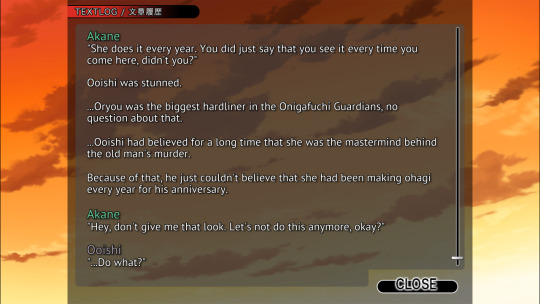
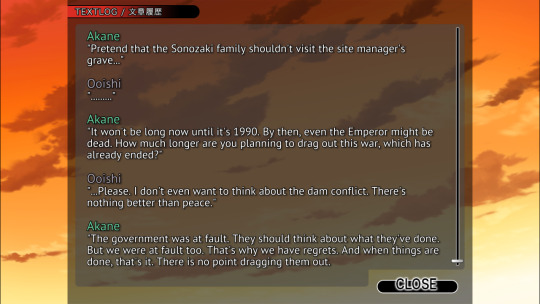
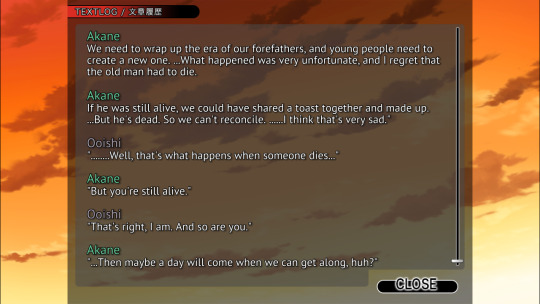
Seems unlikely that the two will send each other Christmas cards. Ooishi then thoroughly confuses the matter by sending a small package of handcuffs to Akane that says “thinking of you.”


I guess something about that line tickled me something fierce, I have five screenshots of this weirdly spread out through this scene. How old do you suppose Akane is? Is she mid-thirties like Takano and Irie? Does she consider herself an old person, or do you think she’s one of those manga characters who refers to themselves as “eternally seventeen?”
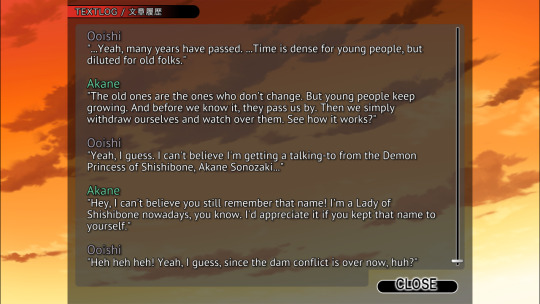
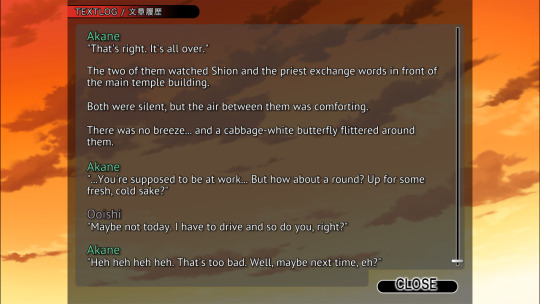
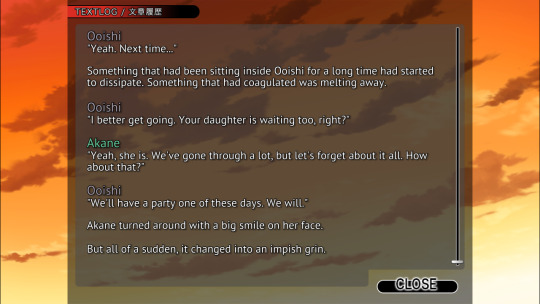
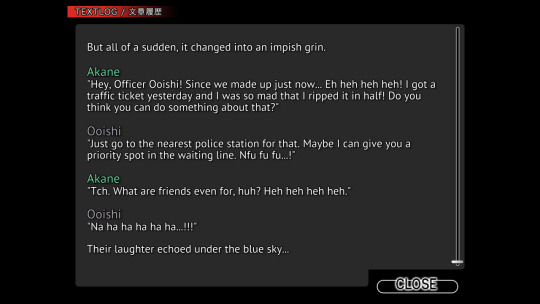
“Let’s get plastered Ooishi.” “Nah, I have to drive, don’t you?” “Nnnnnope, Shion’s taken some stunt driving classes, she’ll be driving.” Cut to Shion wearing her cool Drive jacket as she puts on her driving gloves. You’re mafia royalty Akane, I doubt you drive any where.

Sure is a good thing that Tomitake is none the wiser. Could you imagine the headache it would be if he was aware and suspicious of Takano potentially having ill-intentions?

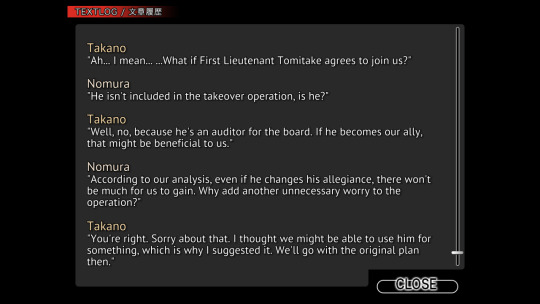
You might recall back in part 42 I asked the question about whether in all of the other fragments if Takano and the Irie Institute are going to be shut down. That probably is the case, but I wonder how she takes the shut down order in these other fragments. In Minagoroshi pt. 17 we see Takano start Operation Doomsday, which included the murder of Tomitake. Only in Minagoroshi Takano didn’t seem all that hesitant or sad about having to take out Tomitake, she put out the feeler to see if Tomitake would be seduced to the dark side, but didn’t seem particularly bothered by the idea of having him killed. So it’s interesting to see that despite killing him at least seven times that we’ve seen that this time around she seems a bit more unwilling to kill him.
There is something about this whole line of thought that strikes me as strange. I’m once again asking you to go back far into the past; in Matsuribayashi pt. 3 Takano is startled awake from a nightmare remembering of her past in the orphanage. When this happens she’s at the mobile command center they used to execute the emergency manual/Operation Doomsday. Then shortly after we get the flashbacks before eventually seeing her meeting Hanyuu at the Furude Shrine before the Connecting Fragments again. So was that a separate variation of the operation? Was it yet another time Rika Furude tried, and failed to change her future? Or am I simply overthinking it, and it was some time prior to the events portrayed here, and it was something like a test run of the manual?
I really don’t understand why Takano’s character has changed so much in this chapter compared to what was shown in Minagoroshi. I suppose you could argue that this is a fuller more realized version of her character, since all that was shown in earlier chapters was really just small snippets of her personality. But I don’t know if I buy that, because every time someone ever mentioned her prior to this chapter it was always mentioned that whichever character is talking about her typically views her as a bit of an odd duck. One who always seemed to have an odd fascination with the history and so on of Hinamizawa. People were so aware of her personality quarks they knew about her penchant for writing fiction about the Hinamizawa parasite, only replacing the parasite for some other fantastical existence. I think it’s fair to assume that the things we see in the Connecting Fragments happen in nearly every version of 1983, concerning Takano at least.
Takano was revealed to have a rather sympathetic side to herself when she talked to Rena about her troubles in Tsumihoroboshi. But, again, this was happening while she was in the midst of planning to execute the manual. So how much of her sympathy she showed to Rena then is up for debate I think, because with all the information that’s been given it’s unclear how much of that was just an act.
She should be unaware of the outside circumstances that are affecting this chapters June 1983, so she should be acting the same as she normally does. So the way that Takano is acting in regards to Tomitake, and her impatience with the Mountain Dogs just seems wildly out of character. Unless, and I believe I mentioned this earlier, Takano herself is infected with Hinamizawa Syndrome and is, unbeknownst to her, approaching terminal levels (Matsuribayashi pts. 33, 60, 62).
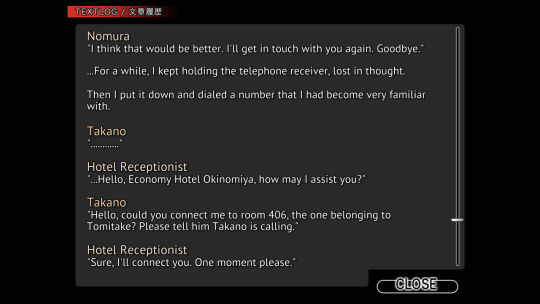

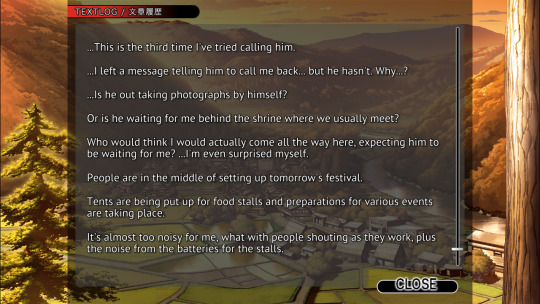
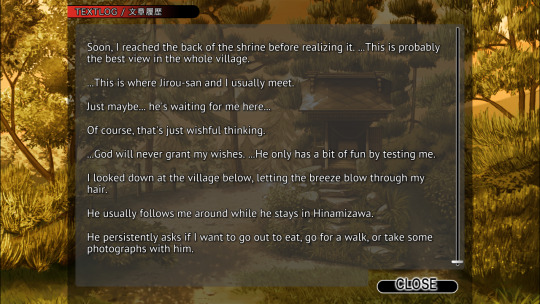
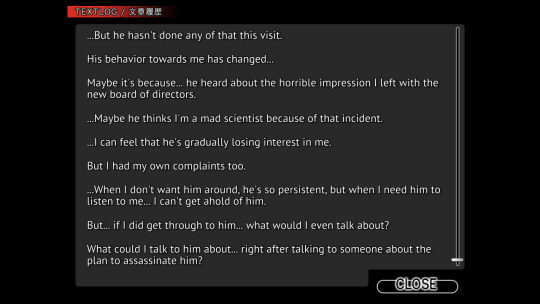
“Jirou-san, if someone were to try to assassinate you, what would be the easiest way to do it?” “Well, Miyo-san, probably an injection of a mystery drug that makes you kill yourself after being wrestled to the ground by other trained soldiers.” “Ara ara, what a specific way.” Then she just hits him in the head with a brick. Without wishing to reference old parts some more, there was that line ages ago where Tomitake remarks on Takano’s need to appear like a villain for some reason or other. Also, Takano, would this be a bad time to remind you that Tomitake has been aware and indeed used for some of your dark deeds? He seemed perfectly aware of your evil ways when you had the Mountain Dogs kidnap the grandson of the construction minister.


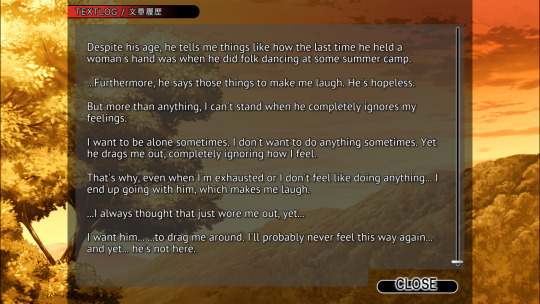
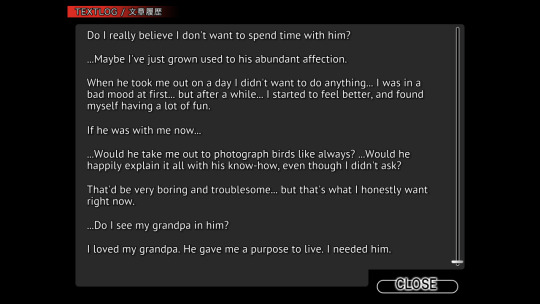
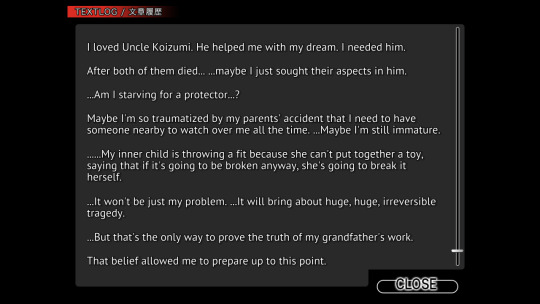
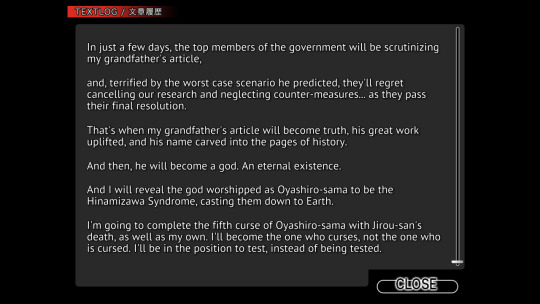

There’s this habit in a lot of writing that occurs where the villain of the work is given a tragic backstory in a bid to make them appear more sympathetic. I don’t particularly care for this device because it comes across to me as the author de-villainizing their villains. Even my beloved Umineko does it with the Golden Witch Beatrice, and I always think it’s some pretty weak sauce.

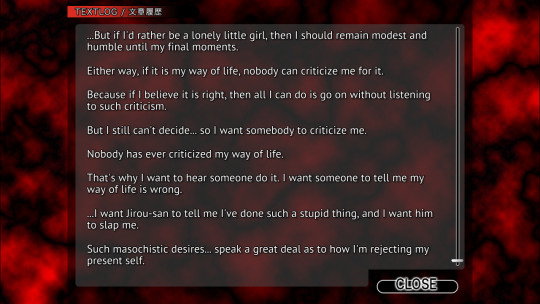

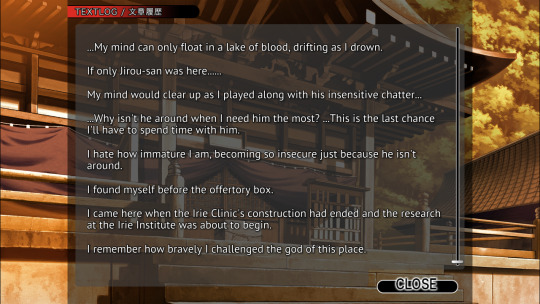
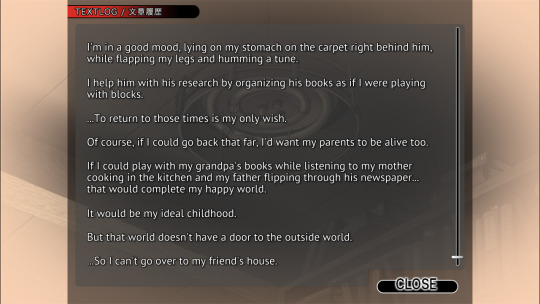
I don’t think this makes Takano more of a compelling character, it reads to me like a weak explanation to try to explain away the things that made her such an intriguing character at the end of Minagoroshi. Even during the Connecting Fragments, and basically up until right now I felt that she was a very strongly written character. Yes, she’s evil, she’s really quite irredeemable, but she was compelling. Having her go from a strongly convicted and self-assured character to this indecisive one is such an incredibly bad misstep that it’s astonishing to read. I was convinced for the longest time that I somehow missed something important that set this up that I reread scenes involving her character again. Unfortunately I couldn’t find anything, yes she was a sad depressed drunk when they shut down her research and Nomura picked her up, but by the end of that encounter she had regained some of her fire and planned to make them all pay. Now though, just because she can’t find Tomitake she’s fallen into this deep depression, and will make further and further bad decisions.
I’ve said before that I find writing about Hanyuu and Rika to be a rather vexing prospect. Takano though, takes the cake because of how thoroughly her character gets ruined by the end of this chapter. Which is a shame, because she’s probably my favorite character in this entire series.
6 notes
·
View notes
Text
BREAKING NEWS: Revolutionary AI Scheduling Model Disrupts Multi-Billion Dollar Industries
IndustriesMay 14, 2025 – In a groundbreaking development set to redefine time management across education, fitness, and the arts, researchers from the Zurich Institute of Technology (ZIT) have unveiled an artificial intelligence model capable of autonomously optimizing human schedules with an accuracy rate exceeding 98.7%.Dubbed "ChronoPilot," the new system leverages deep contextual learning to interpret not only user preferences but also emotional states, productivity trends, and even regional weather forecasts to dynamically tailor personal and group schedules. In early trials, the system outperformed existing scheduling platforms by over 400% in efficiency and conflict resolution.The implications span vast sectors. Educational institutions using class scheduling software like Lunacal’s platform for class bookings have already reported dramatic improvements in attendance and engagement. In the fitness industry, where applications such as gym booking software are crucial, ChronoPilot’s integration led to a 37% rise in client retention during a 90-day pilot. Music academies leveraging music lesson scheduling tools observed a 52% reduction in missed appointments.ZIT’s Secret Weapon: Sentient Sync ProtocolWhat truly sets ChronoPilot apart is its proprietary Sentient Sync Protocol (SSP) — a neural time-mapping engine that mimics human anticipation. SSP doesn’t just block out time; it predicts the best time for each task based on thousands of variables, including circadian rhythms, cognitive load history, and even micro-fluctuations in vocal tone during user interactions.Dr. Lena Marwick, lead AI architect at ZIT, explained, “We’re no longer asking users to fit into rigid schedules. ChronoPilot adapts to them, moment by moment.”Global Trials, Unprecedented ResultsThe AI was tested across 1.2 million scheduling interactions in 11 countries, across five major time zones. In one compelling instance, a public school in Osaka integrated ChronoPilot into its digital classroom system. Within three weeks, student punctuality improved by 48%, and feedback indicated a 63% increase in perceived classroom coherence.Meanwhile, a UK-based national gym chain used ChronoPilot to coordinate personal training sessions across 87 locations. Instructors reported a 41% decrease in downtime, and an average boost of 18% in customer satisfaction scores.ChronoPilot vs. The Old GuardWhile current scheduling tools rely heavily on manual input or rigid templates, ChronoPilot learns from passive inputs — browsing behavior, sleep app data, voice command history — with the user’s consent. This passive data synergy allows it to preemptively adjust schedules without user intervention.Analysts say the AI’s capabilities pose an existential threat to legacy scheduling systems and even to calendar giants like Google Calendar and Microsoft Outlook. “It’s not just a calendar anymore,” says Gideon Lark, senior analyst at MetaMetrics. “It’s a lifestyle orchestrator.”Privacy Concerns and Ethical DebateNot everyone is celebrating. Digital rights watchdogs have raised concerns about the volume and sensitivity of data ChronoPilot processes. The AI can access everything from location logs to biometric signals. While ZIT asserts the system uses end-to-end encryption and offers opt-out data controls, some critics remain wary."We’re trading convenience for surveillance,” warns Aria Salim, director of the Tech Privacy Initiative. “There must be enforceable limits on how such AI models evolve, especially as they begin to predict and possibly influence human behavior.”ZIT has responded by publishing a white paper detailing its privacy protocols and inviting third-party audits. Still, the debate over AI autonomy and human agency continues to intensify.
2 notes
·
View notes
Text
Why are some people’s headlights always so blinding?
Headlight glare is a growing concern as technology advances, vehicle design trends, and regulatory loopholes emerge. Here’s why it’s happening and what you can do about it:
Major causes of headlight glare
Misaligned beam
Cause: Headlights that shine too high (even just slightly) can project light into the eyes of oncoming drivers. This often happens when:
◦ Suspension modifications (such as installing a lift kit or lowering springs).
◦ Bulbs incorrectly replaced without recalibration.
◦ Heavy objects placed in the trunk/back seat change the vehicle’s tilt.
Impact: A 2023 Insurance Institute for Highway Safety (IIHS) study found that one-third of vehicles have incorrectly angled headlights, reducing visibility to other vehicles by up to 50%.
High-intensity bulbs installed in inappropriate housings
LED/HID retrofit kits: Installing high-intensity LED or HID bulbs without dimmable light patterns in halogen reflective housings results in uneven light dispersion. LEDs with dimmable light patterns are the best way to meet standards
◦ Example: A 55W halogen bulb has an intensity of approximately 1,200 lumens, while aftermarket LED bulbs can have an intensity of over 3,000 lumens without proper beam control.
Blue Dominance: Cool white LEDs (7,000K+ color temperature) increase glare due to the longer wavelength of blue light, which scatters more in the human eye.
Taller Vehicle Designs
Taller SUVs, trucks, and crossovers move headlights closer to the driver's line of sight for sedans.
Data point: The average SUV headlight is 22-30 inches above the ground, while the average sedan headlight is 18-24 inches above the ground.
Adaptive system failure
Automatic dimming failure: Adaptive headlights (such as BMW's Dynamic Light Assist) can fail, leaving high beams active.
Sensor issues: Dirty or obstructed windshield cameras/radars (used to detect oncoming vehicles) can cause delays in adjustment.
Lagged regulations
US standards: FMVSS 108 (last updated in 2007) does not adequately address the glare issues of modern LED lights.
Global differences: EU regulations (ECE R112) enforce stricter beam patterns, but imported vehicles may not comply with local regulations.
Human factors exacerbate the problem
Aging drivers: Pupils dilate more slowly as we age, making glare more uncomfortable (studies show that drivers over 50 are twice as sensitive).
Astigmatism: 30% of people suffer from this eye condition, which causes light to distort into starburst shapes.
Cognitive Bias: Drivers often prioritize their own vision over the vision of others, thinking “brighter = safer”.
Solutions and Mitigations For drivers causing glare:
Realign headlights: Use the wall test (25-foot distance) to ensure beam cutoff is level and asymmetrical (slightly higher on the passenger side).
Use certified bulbs: Stick with DOT/ECE/CE/ROSH, etc. certified bulbs designed for your frame.
Adjust for load: Use manual or auto-leveling systems to compensate for heavy loads.
For drivers affected:
Anti-glare measures:
Install auto-dimming rearview mirrors (reduces rear glare by 80%).
Wear polarized sunglasses at night (yellow/amber lenses filter blue light).
Advocate for change: Support organizations like the Insurance Institute for Highway Safety (IIHS) in their push for updated headlight regulations.
Upcoming tech solutions:
Adaptive high beam (ADB): Systems like Mercedes’ digital lighting system or Toyota’s BladeScan can block oncoming vehicles while keeping other areas bright.
Dynamic leveling: Real-time suspension adjustments to maintain beam angle (e.g., Audi’s predictive lighting system).
Why this matters Blazing headlights are not only annoying, they’re also dangerous. Glare can cause:
Temporary blindness: Vision can be impaired for up to 5 seconds after direct exposure (National Highway Traffic Safety Administration).
Increased risk of crashes: A 2022 study showed that glare can lead to a 20% increase in crashes on unlit roads at night.
The bottom line While brighter headlights can improve driver safety, poor design and alignment often come at the expense of others. Until regulations are in place, defensive driving and consumer advocacy are critical. If your lights are frequently flashing, start by checking your beam alignment—it’s often a quick fix, but the impact is high. 🔧🚗

#led lights#car lights#led car light#youtube#led auto light#led headlights#led light#led headlight bulbs#ledlighting#young artist#car culture#cars#race cars#car#classic cars#coupe#suv#chevrolet#convertible#supercar#car light#headlight bulb#headlamp#headlight#lamp#car lamp#lighting#glare#sun glare#death glare
3 notes
·
View notes
Text










I spy… Vignelli!
Summer is always construction season, but we don’t always have Vignelli-designed shipping containers on campus.
“I rarely traveled to any city around the world without seeing one of the containers.” p. 189 “Lella and Massimo Vignelli: Design is One”
From 1992-1998 Vignelli Associates designed the corporate identity for British company Sea Containers (aka Seaco) and their various subsidiaries. In 1995, Seaco was considering a merger with Genstar (the marine container leasing subsidiary of General Electric.)
In a letter to Massimo Vignelli from Seaco says:
“It seems to me the new “GenSeaCo” livery should incorporate some elements of our “Seaco” livery and some elements of the Genstar livery while at the same time saying that GenSeaCo is not wither Sea Containers or General Electric, but instead has its own place in the market.”
In the archives, the Vignellis’ saved some of the process work for the Seaco corporate identity including some ideas that were never implemented.
Images:
1. Snapshot by Archivist Jennifer Whitlock of shipping container with GESeaco logo on construction site on Rochester Institute of Technology campus, 2024
2. page 188 from book “Lella and Massimo Vignelli: Design is One” showing Seaco logo and image of stacked shipping container
3. Master art for Seaco logo
4. pencil sketch of container with Seaco logo
5. sketches for various logo for Seaco and their subsidiaries
6. Color snapshots of shipping containers used to visually test SeaCo logo at full scale with notes
7. SeaCo graphic standards manual draft with sketches and corrections, 1998
8. various iterations of early version logo for Genstar and Seaco merger
9. photocopy of standards manual showing two lengths of shipping container with GESeaco logo
10. vintage color transparency of two trucks hauling GESeaco shipping containers
#vignelli#design#archives#design archives#graphic design#sea containers#1990s#shipping containers#modernism#corporate identity
9 notes
·
View notes
Text
youtube
How to diagnose TB? What are the tests for it?
In public interest, we are bringing you a video series on Tuberculosis, featuring expert Dr. Rajendra Prasad, addressing all your questions and breaking the stigma surrounding TB.
Brief About Dr. Rajendra Prasad :
Professor (Dr.) Rajendra Prasad is a distinguished member of the Internal Advisory Committee of the Help U Educational and Charitable Trust.
A towering figure in the field of Pulmonary Medicine in India, Prof. Rajendra Prasad currently serves as the Director of Medical Education and Professor in the Department of Respiratory Medicine at Era’s Lucknow Medical College and Hospital. He also holds the esteemed position of Emeritus Professor at the National Academy of Medical Sciences, India. His pioneering work has left an indelible mark on medical education, research, and patient care in the country.
With an illustrious career spanning nearly five decades, Prof. Prasad has held several prestigious positions, including:
Director, Vallabhbhai Patel Chest Institute (VPCI), Delhi
Head of Pulmonary Medicine, King George’s Medical University (KGMU), Lucknow
Director, U.P. Rural Institute of Medical Sciences and Research, Saifai
His academic journey began at KGMU, Lucknow, where he completed his MBBS in 1974 and MD in 1979, later advancing his expertise in Pulmonary Medicine, Fiberoptic Bronchoscopy, and Lung Cancer with further training in Japan.
A pioneer in Tuberculosis research and control, Prof. Prasad played a key role in shaping the Revised National Tuberculosis Control Programme (RNTCP), now known as the National Tuberculosis Elimination Programme (NTEP). He was instrumental in establishing the DOTS Center at KGMU, one of the first medical college-based centers in India. A leading advocate for integrating both government and private medical colleges in the TB elimination effort, he currently serves as:
Vice Chairman, National Task Force for Medical Colleges in NTEP
Chairman, Uttar Pradesh Tuberculosis Association
Prof. Prasad's influence extends globally. He has served as the International Governor of the American College of Chest Physicians (USA) and is recognized worldwide as an authority in Pulmonary Medicine. He holds the unique distinction of having presided over all major Indian scientific bodies in the field, including:
National College of Chest Physicians, India
Indian Chest Society
Indian College of Allergy, Asthma & Applied Immunology
Indian Association for Bronchology
Tuberculosis Association of India
His academic and research contributions are prolific. Prof. Prasad has supervised over 215 research studies and authored more than 600 original articles, reviews, and book chapters. He has written 12 books, including four on Tuberculosis, an Atlas on Fiberoptic Bronchoscopy, and a Manual of Chest X-rays based on Indian patients. His work has been globally recognized—Stanford University ranked him among the top 2% of scientists worldwide, both in career-long and recent-year rankings. His academic metrics include:
7,632 citations
H-index: 45
i10-index: 182+
Under his leadership at KGMU, he established several pioneering services in Uttar Pradesh, including:
Video Bronchoscopy (First in the state)
Medical Thoracoscopy
Thoracic Oncology Unit
Air Pollution-Related Disease Diagnostic Center
Sleep Lab
These contributions earned him the title of “Father of Pulmonary Medicine” in Uttar Pradesh, and his former students—now leading pulmonologists across India—regard him as a deeply inspiring mentor.
Prof. Prasad’s relentless dedication to medicine and public health has been honored with over 75 prestigious awards, such as:
Dr. B.C. Roy National Award
Lifetime Achievement Awards from multiple national organizations
Vigyan Gaurav Award, Council of Science & Technology, Government of Uttar Pradesh
UP Ratna Award
O.A. Sarma Oration Award
M. Santosham Oration Award
Dr. Reddy’s Lung Cancer Oration Award
Dr. R.V. Rajam Academic Oration Award, National Academy of Medical Sciences, India
Prof. Rajendra Prasad’s journey is a testament to excellence, perseverance, and an unwavering commitment to medical science. His legacy continues to shape the future of Pulmonary Medicine and serves as an inspiration to generations of doctors, researchers, and healthcare leaders across the world.
#DrRajendraPrasad #टीबीमुक्तभारत #TBMuktBharat #EndTB #StopTB #FightAgainstTB #TuberculosisFreeIndia #TBFreeIndia #StepTowardsTBMuktBharat #TBElimination #NTEP #HealthForAll
#TBHaregaDeshJeetega #PulmonaryMedicine #MedicalEducation #TuberculosisControl
#narendramodi #PMOIndia
#YogiAdityanath #UPCM
#IACM #InternalAdvisoryCommitteeMember
#helputrust #HelpUEducationalandCharitableTrust
#KiranAgarwal #DrRupalAgarwal #harshvardhanagarwal
www.helputrust.org
2 notes
·
View notes
Text

Buy KYC Verified Exchange & Banking Accounts with Fast KYC Verify – Your Gateway to Seamless Crypto Trading
Buy Verified KYC GATE.IO Account GATE.IO is renowned for its gigantic lineup of altcoins as well as trading features unique to it. However, with the verification of KYC, you waste valuable time, particularly during periods of high volume. When you buy a KYC verified GATE.IO account from us, you skip the queue and get futures and spot trading, staking, and more instantly. We employ valid credentials for account verification and provide full login access.
Best for: Scalpers, day traders, crypto startups.
Purchase KYC Verified Kraken Account Kraken is trusted by millions because it is secure and compliant with regulations. Instead of waiting days for KYC verification, you can purchase a KYC verified Kraken account today and start trading right away. Get margin trading, futures, fiat deposits, and more without the stress of onboarding delays.
Best for: Institutional traders, crypto funds, serious investors.
Buy KYC Verified BUNQ Account BUNQ is a modern digital bank with seamless integration for crypto-friendly services. If you’re looking to manage crypto-to-fiat operations or receive payments internationally, you’ll love our KYC verified BUNQ accounts. Fast setup, secure usage, and full control.
Perfect for: Freelancers, crypto entrepreneurs, digital nomads.
Buy KYC Verified Whitebit Accounts Whitebit is a rising star of the exchange world, offering instant trading, great UX, and broad altcoin coverage. When you buy KYC verified Whitebit accounts from Fast KYC Verify, you're ready to roll and can trade and withdraw straight away—no waiting, no document upload.
Best suited for: Newcomers to crypto, global traders, arbitrage masters.
Buy KYC Verified RedotPay Account RedotPay is the smart solution for virtual cards, crypto payments, and cross-border payments. We offer fully verified RedotPay accounts for those who want convenience and privacy in one package. Buy a KYC verified RedotPay account today and unlock the real potential of fintech.
Best suited for: Payment processors, e-commerce users, privacy users.
Why Traders & Businesses Trust Fast KYC Verify Private & Confidential – Your activity and data are never disclosed.
Instant Delivery – Get your verified account within minutes.
100% Verified & Working – Manually tested and verified on every account.
Global Access – Wherever you are in the world, we have you covered.
24/7 Support – Available around the clock to assist you.
How to Order Your Verified Account Take a look at our services and select the platform you need (e.g., Kraken, GATE.IO, Whitebit, etc.).
Contact our support team for price and stock.
Have your verified account securely delivered.
Start trading, withdrawing, or managing funds immediately.
Conclusion
Time equals money in crypto. Avoid having your financial future, trading, and payments delayed by slow KYC processing. With Fast KYC Verify, you can buy KYC verified accounts and have your trading, payments, and financial future owned—faster, wiser, and more secure.
2 notes
·
View notes